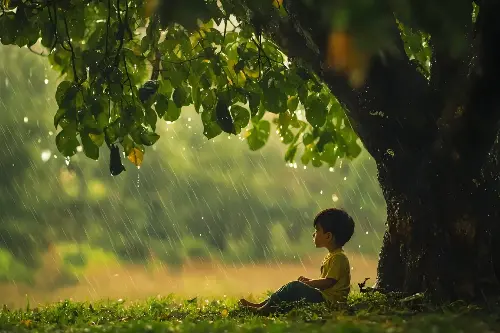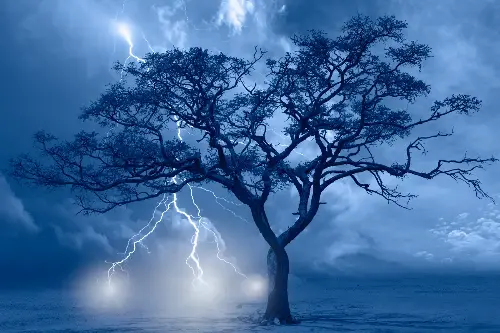Imagine a sudden downpour while you are enjoying a tranquil stroll through the park or a woodland path. Instinctively, many of us would dash for the nearest canopy, seeking refuge under the leafy boughs of a venerable oak or the wide spread of a chestnut's branches. Trees may seem like the perfect natural umbrellas, but this seemingly safe haven could expose you to hidden dangers that are crucial to acknowledge.

Understanding the Risks
When it rains, our primary goal is often to stay dry and protect ourselves from the elements. Trees appear to offer that protection. However, they can also pose significant risks during rainy weather, especially when thunderstorms are involved. Lightning strikes are a grave concern, as trees are often the tallest points in a landscape, making them likely targets. Furthermore, rain-soaked soils can weaken a tree's roots, increasing the risk of it toppling over.
Lightning: Nature's Electrical Menace
Lightning strikes are a powerful force of nature, with each bolt carrying up to a billion volts of electricity. This electrical surge seeks the path of least resistance to the ground, and trees provide such a pathway due to their height and moisture content, which conducts electricity effectively. If you are under or near a tree that is struck, the lightning can jump or 'side flash' to you, causing severe injuries or even fatality. The explosion of sap and splinters can turn into shrapnel, inflicting additional harm. Moreover, the ground current radiating from the strike can electrically charge the surrounding area, presenting another hidden threat.

Injury from Branches and Debris
Even without the drama of lightning, heavy rain alone can weaken branches, causing them to break and fall. Deadwood, often unnoticeable at first glance, is particularly prone to snapping off. Therefore, taking shelter under trees could leave you exposed to the unpredictability of falling debris. In wet weather conditions, what might be a charming spot for a rest or a respite from the sun turns into a zone where the risk of injury from above is significantly enhanced.
Tree Fall and Root Failure
During prolonged periods of rain, the earth becomes saturated, which can destabilize trees. This phenomenon is exacerbated in cases where trees have shallow root systems or where urban infrastructure, such as paving, constrains root growth. When the soil loses its grip on the roots, even a gentle gust of wind can fell a large tree. If you are seeking shelter underneath or near to such trees, you could inadvertently be in the path of a potential collapse.

Safeguarding Yourself in Rainy Weather
All these risks point towards the need for precaution and awareness when the skies darken and showers begin. While completely avoiding all risks is impossible, a few simple measures can increase your safety during inclement weather. It's advisable to check the weather forecast before heading outdoors and plan accordingly. If you're caught in a sudden downpour with the rumble of thunder in the background, heading indoors is your safest bet.
Finding Safer Alternatives
If finding indoor shelter isn't possible, then cars, buses, or covered buildings with non-conductive roofs can provide a safer alternative to trees. These shelters can minimize exposure to lightning strikes and protect from falling branches. However, it is critical to avoid touching metal parts of vehicles or shelters during a thunderstorm, as these can conduct electricity.
Preparedness Goes a Long Way
Carry waterproof clothing or a sturdy umbrella as part of your preparedness kit when venturing out in unpredictable weather. Waterproof attire will keep you dry and reduce the urgency to find shelter under potentially hazardous trees. And remember, no matter how heavy the rain, it is temporary; the risks associated with seeking shelter under trees, however, can have permanent consequences.
As we increasingly appreciate the great outdoors and the benefits of nature, it is easy to overlook the hidden dangers that come with it. While trees are indispensable to our ecosystem and provide countless benefits to our environment, they are not infallible protectors against the elements. Being aware of the risks and planning ahead can help you enjoy the beauty of nature without compromise. So next time the clouds burst, think twice before you dash for the cover of the trees—it might just be a wiser choice to brave the rain or find a safer place to wait out the storm.
